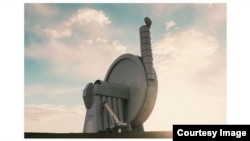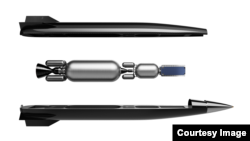An American company has carried out tests of a system that uses a high-speed spinning machine to launch satellites into space.
The machine – which is powered by kinetic energy – is meant to greatly reduce costs and fuel required for traditional rocket launches.
The California-based company that developed the system is called SpinLaunch. It announced its recent test launch last week. The launch took place on September 27 at Spaceport America, a private space launch complex in the western state of New Mexico.
The company said the tests involved payloads from several organizations, including the American space agency NASA. In a statement, SpinLaunch said all payloads tested “were flown and recovered successfully." It did not provide details on what the payloads contained.
SpinLaunch said the September tests included the 10th carried out since October 2021. It added that testing was observed “by more than 150 partners, government officials and industry advocates.”
NASA signed an agreement with SpinLaunch earlier this year to develop and test a payload launch using the company’s system. The agreement was signed as part of NASA’s Flight Opportunities Program. The program provides the chance for private companies to work together with NASA to test new technologies the space agency might use in its future space operations.
NASA is examining the possibility of partnering with SpinLaunch to deploy future payloads using the company’s launch technology. SpinLaunch said NASA cooperated with its team after the latest tests “to capture critical launch characteristics” of SpinLaunch’s kinetic launch system.
SpinLaunch accelerator
SpinLaunch’s Sub-Orbital Accelerator used in the tests is a 33-meter steel structure with an electrically powered spinning arm. A rocket is placed inside the accelerator. The system's high-speed turning motion produces kinetic energy designed to spin the rocket at speeds of more than five times the speed of sound.
The Sub-Orbital Accelerator is built to propel the rocket to near-Earth orbit. This is generally considered to be at an altitude of about 2,000 kilometers above Earth's surface. SpinLaunch has plans to keep expanding its technology and equipment to be able to send space objects into higher orbit.
The company says most satellites can handle the high spinning speeds, although some will require special modifications to work with the system. With the Sub-Orbital Accelerator, a separate propulsion system would be necessary for satellites to reach higher orbits.
SpinLaunch officials said tests of the system have resulted in the flight vehicles being recovered and that the rockets can be reused.
Jonathan Yaney is the founder and chief executive of SpinLaunch. He said in a statement that the latest flight tests will be “invaluable” for SpinLaunch engineers as well as the company’s partners. He added that the company will continue working to further develop the system to provide a “low-cost and sustainable” way to deploy satellites to space.
Yaney said the SpinLaunch system and the way it operates is much less complex than traditional rocket launching systems. This greatly cuts launch costs for large organizations and small companies alike. In addition, the lack of fuel needed to send objects into near Earth orbit represents a much more environmentally friendly system.
The technology is being tested as the demand for satellite deployments continues to grow. Market research company IMARC Group recently reported the worldwide small satellite market reached $3.68 billion in 2021. The group projects the market will rise to $8.84 billion by 2027.
I’m Bryan Lynn.
Bryan Lynn wrote this story for VOA Learning English, based on reports from SpinLaunch and NASA.
___________________________________________________________________
Words in This Story
kinetic – adj. involving or producing movement
payload – n. the amount of goods or people carried by a vehicle
characteristic – n. a typical quality that makes one thing different from another
modify – v. to change something in order to improve it
propel – v. to push something somewhere with a lot of force
advocate – v. someone who supports a particular idea or cause
sustainable – adj. able to continue over time
_______________________________________________________________________
What do you think of this story? We want to hear from you. We have a new comment system. Here is how it works:
- 1. Write your comment in the box.
- 2. Under the box, you can see four images for social media accounts. They are for Disqus, Facebook, Twitter and Google.
- 3. Click on one image and a box appears. Enter the login for your social media account. Or you may create one on the Disqus system. It is the blue circle with “D” on it. It is free.
Each time you return to comment on the Learning English site, you can use your account and see your comments and replies to them. Our comment policy is here.












Forum